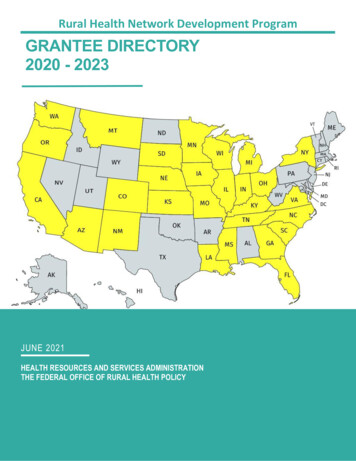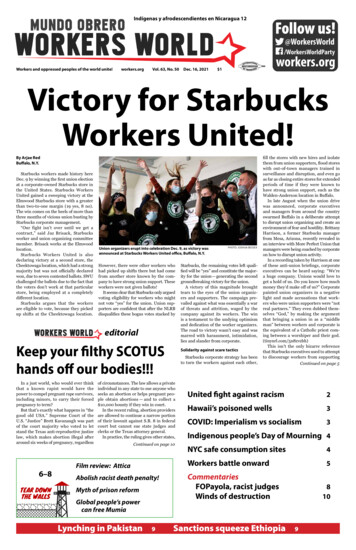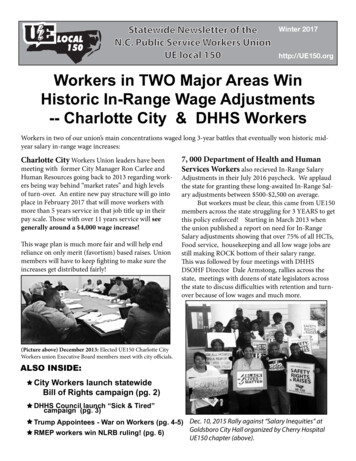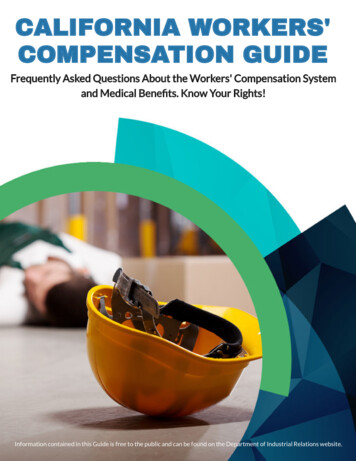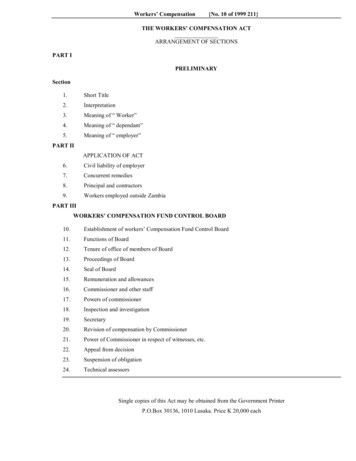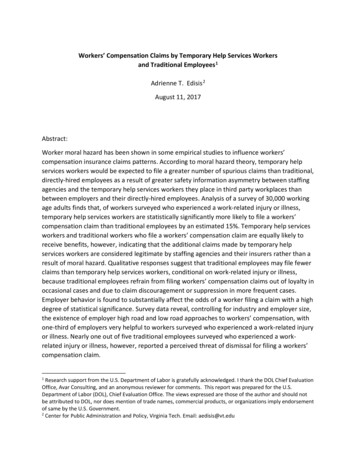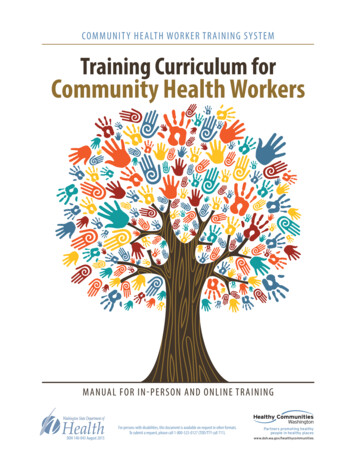
Transcription
COMMUNIT Y HEALTH WORKER TR AINING SYSTEMTraining Curriculum forCommunity Health WorkersMANUAL FOR IN-PERSON AND ONLINE TR AININGDOH 140-043 August 2015For persons with disabilities, this document is available on request in other formats.To submit a request, please call 1-800-525-0127 (TDD/TTY call 711).Partners promoting healthypeople in healthy placeswww.doh.wa.gov/healthycommunities
Partnerships and AcknowledgmentsPartnersThank you to the following partners for making this project possible. Department of Health, Office of Healthy Communities (OHC)Department of Health, Breast, Cervical and Colon Health Program (BCCHP)Comprehensive Health Education Foundation (CHEF)Massachusetts Department of Public Health (MDPH)Care Coordination Consulting; Marilyn Gardner, Mary Lou Woodford, and Mariuca TuxburyThis work was funded in part by a federal grant from the Centers for Disease Control.Program Contacts Scott Carlson, Community Health Worker Program ManagerOffice of Healthy Communities – Access, Systems & CoordinationPhone: 360-236-3792Email: scott.carlson@doh.wa.gov Debbie Spink, Community Health Worker Training CoordinatorOffice of Healthy Communities – Access, Systems & CoordinationPhone: 360-236-3717Email: debbie.spink@doh.wa.gov Robert Pocklington, Community Health Worker Training CoordinatorOffice of Healthy Communities – Access, Systems & CoordinationPhone: 360-236-3442Email: robert.pocklington@doh.wa.govPrimary AuthorsCarlos Mejia-RodriguezDebbie Spink, MAGraphic DesignerVonda Witley
Table of ContentsChapter 1: Community Health Worker Training SystemPage 1BackgroundTeaching PhilosophyIn-Person/Online Training CombinationAdditional Learning Opportunities for Community Health Workers — Health Specific ModulesChapter 2: In-Person TrainingPage 3Roles and Boundaries of Community Health WorkersCommunicationCultural CompetencyChapter 3: Navigating the Online SystemCHWTS: The First Five ModulesModule 1: WelcomeModule 2: Organizational SkillsModule 3: Documentation SkillsModule 4: Assessment SkillsModule 5: Service Coordination SkillsModule 6: Writing and Presenting a Case StudyPage 11
COMMUNIT Y HEALTH WORKER TR AINING SYSTEM MANUAL FOR IN-PERSON AND ONLINE TR AINING
Chapter 1Community Health Worker Training SystemBackgroundThe Massachusetts Department of Public Health in collaboration with the MassachusettsArea Health Education Center (AHEC) of Central Massachusetts, a nationally recognizededucator of Community Health Workers, and the AHEC of Southeastern Massachusettsoriginally developed the curriculum. The training was first implemented in the MassachusettsDepartment of Public Health Women’s Health Network and expanded to the MassachusettsCare Coordination Program. After evaluation and modification, the program has beenimplemented statewide in Massachusetts.This training was first implemented in Washington State in 2011. We worked with theComprehensive Health Education Foundation to modify the training to meet the needsof Community Health Workers in all settings. The primary course and pre-requisite to allother modules, is the Core Competencies Course. After successful completion of the CoreCompetencies, Community Health Workers can enroll in additional health specific modulesto continue their education and expand their knowledge base.The goal of this training is to improve the competencies of Community Health Workersacross the state of Washington through consistency. We combined distance learning(online) techniques with traditional (classroom) style teaching to form a hybrid. The CoreCompetencies Course will be offered quarterly in seven regions of the state beginning inOctober 2012.Teaching PhilosophyThis training uses a unique but tested teaching philosophy. Each course and module utilizesco-trainers. One trainer has real life experience working as a Community Health Workerand the other has content knowledge and expertise. Together the co-trainers can deliver thecontent that is most appropriate for the participants. Co-trainers from the community areable to bring real life case studies and community problems to the training.In-Person/Online Training CombinationThere are many benefits of hybrid training. The in-person components allow participantsto meet each other and the instructors in a face-to-face environment. The benefit of bodylanguage and interactive communication skill building sets the stage for a more robust onlineexperience.The online sessions allow participants to choose their work environment, eliminating the needfor travel and time away from work and home. The online portion also allows for consistencyand repetition of content. Each participant can review the content as many times as neededand review the course materials at their own pace.COMMUNIT Y HEALTH WORKER TR AINING SYSTEM MANUAL FOR IN-PERSON AND ONLINE TR AINING1
The first in-person training day introduces participants to the DOH CHWTS facilitatorsand the co-trainer of their region. Participants receive the training manual and instructionson how to participate in the online portion of the training. Components of the first day inperson training include: Definition of CHWCHW roles and boundariesCommunicationCultural competencyNavigating the online systemThe second in-person training day follows the completion of the online course and is thelast day of the training. Participants will meet with co-trainers to share and evaluate theirexperience, and share ways they plan to implement what they learned in the training. Thisday is a culmination of the course content. Participants discuss their experience with onlinecontent, demonstrate their competencies in the content learned and share their knowledge oflocal resources. Service coordination is a large part of the take away knowledge. Sharing andbuilding on the local, regional and national resources that each Community Health Workerhas are an important outcome of the course. At the end of the day, participants will receive aCertificate of Completion.Additional Learning Opportunities for Community Health Workers — Health Specific ModulesIt is the intent of the Washington State Department of Health to develop and offercontinuing education on health specific topics and other areas of interest for CommunityHealth Worker development. The following health specific modules are currently available asadditional learning opportunities. 2Behavioral HealthcareBreast Health and Breast CancerBlood Pressure/HypertensionCardiovascular Health and Heart DiseaseCervical Health and Cervical CancerColorectal Health and Colorectal CancerHealth Coaching and Motivational InterviewingHealth LiteracyHealthy Eating Active LivingNavigating Health InsurancePre-Diabetes and DiabetesProstate Health and Prostate CancerSocial Determinants of Health DisparitiesCOMMUNIT Y HEALTH WORKER TR AINING SYSTEM MANUAL FOR IN-PERSON AND ONLINE TR AINING
Chapter 2In-Person TrainingBefore beginning the online portion of the training, you will be required to participate in aone-day in-person session. The agenda for the in-person day includes Community HealthWorker roles and boundaries, communication and cultural competency skills, and navigatingthe system.Roles and Boundaries of Community Health WorkersCHWs are trusted members of the community who apply a unique understanding of theexperience, language, and culture of the people they serve to carry out one or more of thefollowing roles: Provide culturally appropriate health education, information, and outreach incommunity settings. This includes homes, schools, clinics, shelters, local business, andcommunity centers.Bridge the gap between communities and health and human services by increasingpeople’s health knowledge and ability to be self-reliant.Make sure people access the services they need.Advocate for people and community health needs.Provide direct services, such as: Informal counseling. Social support. Care coordination. Health services enrollment and health insurance navigation skills. Ensure preventive health screening for cancer.CommunicationVerbal, non-verbal and para-verbal messages Verbal Send clear, concise messages Receive and Correctly Understand messages sent to us Effective verbal messages– Are brief, succinct, and organized– Are free of jargon Non-verbal messages Facial expressions Postures and gesturesCOMMUNIT Y HEALTH WORKER TR AINING SYSTEM MANUAL FOR IN-PERSON AND ONLINE TR AINING3
Para-verbal messages Includes the tone, pitch, and pacing of our voice When we are angry or excited, our speech tends to become more rapid and higherpitched. When we are bored or feeling down, our speech tends to slow and take on amonotone quality. When we are feeling defensive, our speech is often abrupt.Active listening Give undivided attention to the speaker in an effort to understand their point of view Use verbal “encouragers” like “aha,” “hmm,” “yes” Use non-verbal messaging by nodding, smiling, leaning forward Forces people to listen attentively Avoids misunderstandings Confirms what was heard Helps to open the conversation to get more information Paraphrased statements Translate into your own words what the speaker said Reflecting facts Briefly summarize content or facts of what someone has said Reflecting feelings When someone is expressing feelings, convey empathy and encourage them tocontinue. Reflect back the feelings, “it sounds like you’re feeling frustrated with.” Summarizing Blend the ideas into one themeCross-cultural communication Maintain etiquette Slow down Take turns Check meanings Avoid slang Separate questionsBarriers to communication Poor listening skills Stereotyping Cross-cultural differencesOutcomes of poor communication Mistakes Lack of efficiency Poor coordination Frustration and anger Conflict Low morale Loss of team spirit4COMMUNIT Y HEALTH WORKER TR AINING SYSTEM MANUAL FOR IN-PERSON AND ONLINE TR AINING
Email communication Email is a conversation Read first, send later—hold back until you have taken a breath. Buy time. Write clearly and concisely Make sure your subject line is clear—Avoid a subject line of “hi”Cultural CompetencyNavigating the world with intercultural communication We are a global community You don’t need to travel around the world to learn the differences Intercultural communication Is a passport to learn about cultureWhat is culture?Definition: Anthropologist Daniel G. Bates defines culture as “The system of shared beliefs,values, customs, behaviors, and artifacts that the members of society use to cope withtheir world and with one another, and that are transmitted from generation to generationthrough learning.”Other definitions of culture Deposit of knowledge, experience, beliefs, values, attitudes, meanings, religion,hierarchies, notions of time, roles, spatial relations, concepts of the universe, andmaterial objects and possessions acquired by a group of people in the course ofgenerations through individual and group striving System of knowledge shared by a relatively large group of people Culture is communication and communication is culture A way of life of a group of people- the behaviors, beliefs, values, and symbols thatthey accept, generally without thinking about them, and that are passed along bycommunication and imitation from one generation to the next. Culture is symbolic communication; some of the symbols include a group’s skills,knowledge, attitudes, values, and motives. The meanings of the symbols are learnedand deliberately perpetuated in society through institutions. Patterns, explicit and implicit, of and for a behavior acquired and transmitted bysymbols, constituting the distinctive achievements of human groups, including theirembodiments in artifacts, the essential core of culture consist of traditional ideas andespecially their attached values are transmitted from generation to generation. Culture is a collective programming of the mind that distinguishes the members ofone group or category of people from another?Is culture genetic?An important, if not critical, feature of culture is that it is learned. Culture acts like atemplate, shaping our behavior and beliefs from generation to generation. Each of us has acultural template in place even before we are born. Culture is not genetic. Cannot be attributed to genetic inheritance.COMMUNIT Y HEALTH WORKER TR AINING SYSTEM MANUAL FOR IN-PERSON AND ONLINE TR AINING5
Stereotyping Culture is our lens. It determines how we interpret what we see. Same words — different meaning Same objects — different uses To interpret human behavior we need to understand three dimensions: A “universal dimension” refers to ways in which people in all groups are the same. A “cultural dimension” refers to traits a particular group of people have in commonand how they are different from every other group. The groups are almost limitless. A “personal dimension” describes the ways in which each of us is unique. We mayeven be different from others in our group on a personal level. We cannot consciously process large amounts of information, so our brain tends tocategorize things and place them into groups. We group things based on limited information. Many of us note outwardcharacteristics first, and our strongest instinct is to group people by age, gender, andrace, based on physical cues. The part of culture that is visible is only a very small part of a much bigger whole.We see people’s behaviors, but we do not see the values and beliefs that shape thosebehaviors. When we encounter a new person, our brain automatically activates a schema for thatperson based on physical cues and our experiences. We apply attributes that are not supplied by the new interaction. We can use theseschemas as starting points to learn more about the individual person, event, or place. When it comes to culture, we should be “learners”, not “knowers.” Culture has aspects that are observable and others that can only can be suspected orguessed.Cultural self-awareness What we want from others is recognition, respect, understanding and empathy. No matter what groups you belong to, this is a universal concept, and one that youshould keep in mind throughout your career. It is critical that we not only recognize the differences among all of us, but that wealso respect those differences.What is cultural competency?Definition: Cross, Bazam, Dennis and Isaacs define culture competency as “A congruentset of behaviors, attitudes, and policies that come together in a system, agency, or amongprofessionals and enables that system, agency, or those professionals to work effectively incross-cultural situations. 1999–2000: Federal Government establish standards for cultural competency6COMMUNIT Y HEALTH WORKER TR AINING SYSTEM MANUAL FOR IN-PERSON AND ONLINE TR AINING
Why do we need cultural competency? To sustain culturally competent relationships by recognize behaviors and beliefs. To treat people with Respect and Dignity To create effective and efficient cross-cultural relationships It enables us to adapt to cross-cultural situationsWhy do we need cultural competency in our role as CHWs? Community Health Workers are needed Their competency is required to better serve their communities There is an increasing number of diverse communities There is an increasing amount of health disparities There is an increasing interest from founders and regulatorsWashington State Demographics Population (2013 estimate): 6,973,742Population (2010): 6,724,543Percent change: 3.7%Persons under 5 years: 6.4%Persons under 18 years: 22.9%Person 65 years and over: 13.6%Female persons: 50.0%Foreign born persons: 13.2%Language other than English spoken at home: 18.5%White persons: 81.2%Black persons: 4.0%AI and AN: 1.9%Asian: 7.9%Native Hawaiian and other PI: 0.7%Hispanic/Latinos: 11.9%Two or more races: 4.4%White non-Hispanics: 71.0%Retrieved from: COMMUNIT Y HEALTH WORKER TR AINING SYSTEM MANUAL FOR IN-PERSON AND ONLINE TR AINING7
Health DisparitiesDefinition: “the difference in the incidence, prevalence, morbidity, mortality, and burden ofdiseases and other adverse health conditions that exist among specific population groups.”Source: National Institute of Health (1999)Retrieved from �A population is a health disparity population if there is a significant disparity in theoverall rate of disease incidence, prevalence, morbidity, mortality or survival rates in thepopulation as compared to the health status of the general population.”Source: National Center for Minority Health and Health Disparities (2000). Minority health andHealth Disparities Research and Education Act. United States Public Law 106, 525, p. 2498Retrieved from alth equity and health care Low-income and minority neighborhoods are less likely to have access to recreationalfacilities and full-service grocery stores and more likely to have higher concentrationsof retail outlets for tobacco, alcohol, and fast foods. Adolescents who grow up in neighborhoods characterized by concentrated povertyare more likely to be a victim of violence; use tobacco, alcohol, and other substances;become obese; and engage in risky sexual behavior. Low-income and minority populations are at increased risk of being exposed topollution. As a result, they face higher risks for poor health outcomes, such as asthma. Coronary heart disease and stroke account for the largest proportion of inequality inlife expectancy between whites and blacks, despite the existence of low-cost, highlyeffective preventive treatment. On average, adults with serious mental illness die 25 years earlier than their peers,largely due to preventable health conditions. Adults with disabilities are more likely to report their health to be fair or poor and toexperience unmet health care needs due to costs. Residents of rural areas are more likely to have a number of chronic conditions(e.g., diabetes, heart disease) and are less likely to receive recommended preventiveservices (e.g., cancer screening and management of cardiovascular disease) in part dueto lack of access to physicians and health care delivery sites. Lesbian, gay, bisexual, and transgender (LGBT) individuals may be at increased riskfor negative health behaviors (e.g., smoking, underage alcohol use) and outcomes(e.g., sexual assault, post-traumatic stress disorder, obesity). However, only a limitednumber of reports include information on sexual orientation, making it difficult tounderstand the extent of health disparities and how best to address them. In 1999 congress requested to Institute of Medicine to assess the extent of racial andethnic disparities in health care. The study committee was struck by what they found.Source: Institute of Medicine. (2002). Unequal Treatment: Understanding racial and ethnic disparitiesin health care.8COMMUNIT Y HEALTH WORKER TR AINING SYSTEM MANUAL FOR IN-PERSON AND ONLINE TR AINING
CLAS Standards for Health EquityCulturally and Linguistically Appropriate Services: The CLAS standards are primarily directedat health care organizations; however, individual providers are also encouraged to usethe standards to make their practices more culturally and linguistically accessible. Theprinciples and activities of culturally and linguistically appropriate services shouldbe integrated throughout an organization and undertaken in partnership with thecommunities being served.14 standards organized by themes Culturally Competent Care (Standards 1-3), Language Access Services (Standards 4-7), Organizational Supports for Cultural Competence (Standards 8-14).Within this framework, there are three types of standards of varying stringency:mandates, guidelines, and recommendations as follows:CLAS mandates are current Federal requirements for all recipients of Federal funds(Standards 4, 5, 6, and 7).CLAS guidelines are activities recommended by OMH for adoption as mandates by Federal,State, and national accrediting agencies (Standards 1, 2, 3, 8, 9, 10, 11, 12, and 13).CLAS recommendations are suggested by OMH for voluntary adoption by health careorganizations (Standard 14).Source: US Department of Health and Human Services OPHS. Office of Minority Health (2001).National Standards for culturally and linguistically appropriated services in health care.Washington, D.C.Cultural TriadThere are three basic concepts and attitudes that support cross-cultural competency whenyou are exposed to encounters at community or clinical levels with individuals of differentcultures: Empathy Curiosity RespectWhy isn’t it easy?Barriers to cultural competency: Cultural Blindness Cultural Shock Cultural Conflict Cultural Imposition Ethnocentrism Racism and DiscriminationCOMMUNIT Y HEALTH WORKER TR AINING SYSTEM MANUAL FOR IN-PERSON AND ONLINE TR AINING9
Cultural Competency Tools Recognize what your cultural values are, be awareLimited language proficiency does not mean limited intellectual abilityAllow storytelling, most cultures communicate through storytellingRemember that you don’t know everything, and you are still learningAlways seek help from co-workers and individuals with more bilingual or biculturalexperience. Seek ongoing training opportunities in cross-cultural communication because cultureis always evolving.10COMMUNIT Y HEALTH WORKER TR AINING SYSTEM MANUAL FOR IN-PERSON AND ONLINE TR AINING
Chapter 3Navigating the Online SystemCHWTS: The First Five ModulesModule 1: WelcomeIntroduction: Welcome to the Washington State Community Health Worker TrainingSystem. This module is designed to introduce you to the online system and to the otherparticipants.Goal: Community health workers will get to know the online system and the otherparticipants.Objectives: Introduce yourself to the rest of the class Understand course schedule and sequence of assignments Complete pre-assessmentTo scroll through the pages of this module, click on the blue arrow in the upper right hand side ofthe screen or click on the title of the next section from the list in the light blue left side of the page.From the Home page, click on 1 Welcome on the left side of the page in the light blue column.Read the text.1.1 Requirements and FeaturesClick on Requirements and Features. Read through the text.1.2 Introductions Read through the facilitator’s introductions. Click on the Forum entitled 1.1. Introductions. Then click on the thread that says Introductionsand leave a paragraph introducing yourself to you fellow classmates and online facilitator.1.3 Course ScheduleRead through the course schedule.1.4 Pre-AssessmentTake the pre-course quiz.COMMUNIT Y HEALTH WORKER TR AINING SYSTEM MANUAL FOR IN-PERSON AND ONLINE TR AINING11
Module 2: Organizational SkillsIntroduction: Working in a busy health care setting or at the community level withmany responsibilities and tasks can be overwhelming. This module will help you improve yourorganizational skills with tools to help you be more successful in your role.Goal: Community health workers will demonstrate appropriate organizational skills andstrategies.Objectives: At the end of this module, Community Health Workers will be able to: Identify the reasons why good organizational skills are essential to the role of CHWs. Prioritize activities in relationship to patient care and competing demands. Identify the organizational tools and procedures required by their organization orpersonal level. Develop weekly work plans.To scroll through the pages of this module, click on the blue arrow in the upper right hand side ofthe screen or click on the title of the next section from the list in the light blue left side of the page.From the Home page, click on 2 Organizational Skills on the left side of the page in the light bluecolumn. Read the discussion.2.1 Participation Activity Click on 2-1 Why Skills? Next window, click on Organizational Skills. You are now at the Forum for this activity. Scroll down until you see the empty box titled Post Message. Type your comments in the text box titled Body. When you are finished writing, scroll down to the bottom of the page and click the bluePost box.2.2 Organizational SkillsRead discussion. Click blue arrow at right top corner of page to go to next page.2.3 Time ManagementRead discussion. Click on Balancing Priorities Activity. This will take you to the Tests & Surveys page. Click on Balancing Priorities and follow directions for completing quiz. After completing the quiz, click on the blue arrow at the top right of the page. Scroll down to the last paragraph. Read paragraph then click on 2-2 Balancing Priorities. This will take you to a new page. Click on Balancing Priorities under the blue line in the middle of the page. You are now at the Balancing Priorities Forum. Scroll down until you see the empty text box. Click on the body and type in your post.When finished, scroll to the bottom of page and click Post.12COMMUNIT Y HEALTH WORKER TR AINING SYSTEM MANUAL FOR IN-PERSON AND ONLINE TR AINING
2.4 Organizing and Planning Your TimeRead discussion. Follow directions. Click on Ten Ways to Organize Your Time. Print and place in resource manual. Click on arrow at top right of page to continue.2.5 Time Management TipsRead discussion. Click blue arrow at right top corner of page to go to next page.2.6 Multidisciplinary Team and ExpectationsRead discussion. Click blue arrow at right top corner of page to go to next pageResource Activity.2.7 Resource ActivityRead and follow directions. Click on Weekly Workplan Template. Fill in your information and save it in your documents. To turn in assignment, click on the tab at the top of the page titled Assignment Dropbox. Click the Browse button. When you locate and double click on your document, the URL will appear in the boxnext to the browse button. Click on the Upload button to turn in assignment. Click on the arrow button in the upper right hand corner to go to the next page. Use Module 2 Worksheet 1 from the manual if you want to write your comment out beforeyou type it in and upload it.2.8 Organizational Skills Case Study Audio Activity: Listen to audio and follow along with script. Participation Activity: Click on 2-3 Organizational Skills: Carmen.This will take you to another page where you can click on Case Study: Carmenin the middle of the screen. You are now at the Forum page. Scroll down until you see a blank text box with Post Message box at the top left. Type inyour discussion in the box labeled Body. When you are finished typing your discussion, scroll to the bottom of the page and clickPost. You are encouraged to read and comment on your classmate’s discussion posts.2.9 Organizational Skills Quiz Click on Organizational Skills Quiz in the middle of the page. This will take you to the Tests &Surveys page. Click on Organizational Skills Quiz and complete quiz.You finished your second module, Organizational Skills. Keep participating in the forum.COMMUNIT Y HEALTH WORKER TR AINING SYSTEM MANUAL FOR IN-PERSON AND ONLINE TR AINING13
Module 3: Documentation SkillsIntroduction: This module covers documentation skills essential to your work as aCommunity Health Worker. Please note that while we will discuss key concepts related todocumenting your work with patients, or people in need of services, it is important to alwaysidentify and follow your program's specific policies for documentation or develop personalguidelines.Goal: Community health workers will demonstrate appropriate documentation skills andstrategies in order to be successful in their role.Objectives: At the end of this module, Community Health Workers will be able to: Identify the reasons why effective documentation is essential to the role of CHW Identify the documentation requirements expected of CHW at their organization or atpersonal level Use appropriate techniques to document patient encounters, contacts, or servicesprovided.To scroll through pages of this module, click on the blue arrow in the upper right hand side of thescreen or click on the title of the next section from the list in the light blue left side of the page.From the Home page, click on 3 Documentation Skills on the left side of the page in the light bluecolumn. Read the discussion.3.1 Participation Activity Read text and click on 3-1: Documentation Practices. This will take you to the Forum for this activity. Scroll down until you see a blank text box with Post Message at the top left. Type your discussion in the box labeled Body. When you are finished typing your discussion, scroll to the bottom of the page and clickPost. You are encouraged to read and comment on your classmate’s discussion posts. Once you post, click on the blue arrow at the top right of the screen to go back to theassignment page. Click on the blue arrow again to continue with the course.3.2 Documentation SkillsRead discussion. Click blue arrow at right top corner of page to go to next page.3.3 Documentation SampleRead discussion. Click blue arrow at right top corner of page to go to next page.3.4 Documenting EffectivelyRead discussion. Click blue arrow at right top corner of page to go to next page.14COMMUNIT Y HEALTH WORKER TR AINING SYSTEM MANUAL FOR IN-PERSON AND ONLINE TR AINING
3.5 Documentation ChallengesRead the discussion. Click on 3-2 Documentation Challenge. This will take you to the Forum for this activity. Scroll down until you see a blank text box with Post Message at the top left. Type in your discussion in the box labeled Body. When you are finished typing your discussion, scroll to the bottom of the page and clickPost. You are encouraged to read and comment on your classmate’s discussion posts. Once you post, click on the blue arrow at the top right of the s
Debbie Spink, Community Health Worker Training Coordinator Office of Healthy Communities - Access, Systems & Coordination Phone: 360-236-3717 Email: debbie.spink@doh.wa.gov Robert Pocklington, Community Health Worker Training Coordinator Office of Healthy Communities - Access, Systems & Coordination Phone: 360-236-3442
